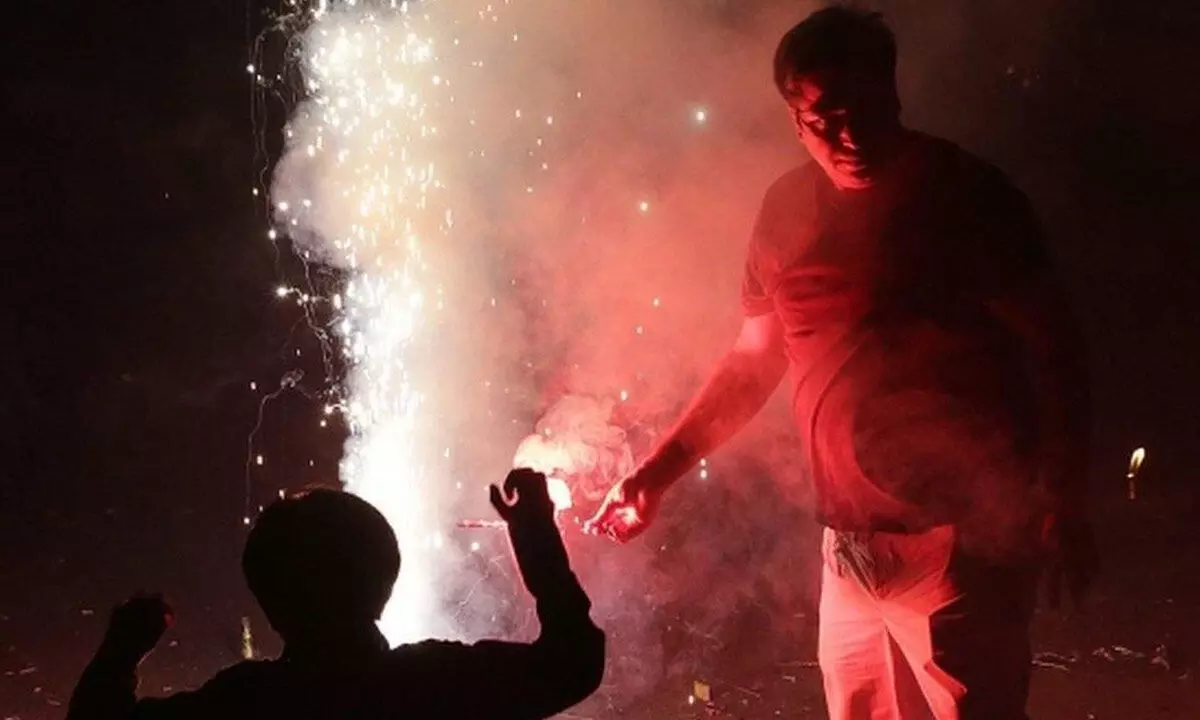First smog event of season chokes national capital

Season’s first smog event quite predictably built up on the Diwali day with a rapid and substantial increase in particulate pollution compared to the pre-Diwali days.
New Delhi: Season’s first smog event quite predictably built up on the Diwali day with a rapid and substantial increase in particulate pollution compared to the pre-Diwali days.
Sharp rise on Diwali night: Particulate Matter 2.5 (PM2.5) levels that were already rising steadily during the preceding five days leading up to Diwali, showed a marked increase of 46 per cent from October 28 through October 31. By midnight on October 31, PM2.5 hit a peak of 603 microgram per cubic metre (µg/m³)—13 per cent higher than Diwali peaks observed in both 2022 (when Diwali had occurred on October 24) and 2023 (on November 12). (see Graph 1: Hourly movement of PM2.5 in Delhi)
High peak on Diwali night: The 12-hour (from 8 PM to 8 AM) of PM2.5 concentration on Diwali night in 2024 was 34 per cent higher than Diwali night in October 2022,-- which was also an October celebration-- going from 289 µg/m³ to 386 µg/m³. Moreover, PM2.5 levels this year were more than twice as high as the average night-time pollution recorded over the seven nights before Diwali. (Graph 2: PM2.5 levels Diwali-night (8 pm-8 am) vs average of nights in the week preceding Diwali)
Quick build up and dissipation of Diwali night pollution: However, the unique pattern of Diwali trend this year was sudden sharp increase at night and also quicker dissipation the day after. The PM2.5 was in the poor category during the afternoon of October 31st. But the evening build-up peaked to hit the severe levels during mid-night and stayed elevated until early morning next day. This time the dissipation has occurred quicker compared to previous years – not lasting as a smog episode (that is remaining elevated at severe level for at least three consecutive days). It came down to more moderate levels of 97 µg/m³ by noon. (see Graph 3: Trend in Diwali night Pollution in Delhi).
Favourable atmospheric conditions helped: The reasons behind this late build up and early dissipation of pollution on Diwali day were warm atmospheric conditions with relatively more efficient natural ventilation and adequate wind in the city. This is supposed to be one of the warmest October this year.
Differing trend during the day: Interestingly, the daytime (6 AM to 4 PM) air pollution on Diwali day showed comparatively higher levels. The average PM2.5 concentration during the day was 92 per cent higher than last year’s Diwali daytime average that was affected by the deeper inversion conditions of the winter. This reflects high local and regional pollution aided by the sharp increase in the share of farm fires.
Pollution hotspots on Diwali night: There was a massive build-up of pollution in different parts of the city on Diwali night – hitting severe levels and increasing the peak exposure levels for a large section of the population. This year, 9 out of 38 air quality monitoring stations recorded PM2.5 concentrations exceeding the critical threshold of 900 µg/m³ on Diwali night. The highest levels were observed at Nehru Nagar, reaching 994 µg/m³, followed closely by Anand Vihar at 992 µg/m³, Pusa IMD at 985 µg/m³, Wazirpur at 980 µg/m³, and JLN Stadium at 963 µg/m³. Other affected areas are Okhla, CRRI-Mathura Road, Karni Singh Stadium, Lodi Road, Siri Fort etc (Graph 4: Hourly peak pollution in different parts of Delhi on Diwali-night)
Contribution from farm fires increased sharply on Diwali day: There was sudden and sharp escalation in farm fire count on the day of Diwali and that combined with the change of wind direction to north westerly. This increased the share of its contribution to Delhi’s air quality by 27 per cent. According to the data from the IARI the fire count had increased from 60 on October 30 to 605 on October 31. (See Graph 5: Contribution of farm fire peaks on Diwali day). Punjab accounted for the highest share at 80 percent, followed by Uttar Pradesh at 13 percent, and Haryana at 7 percent. North-westerly winds prevailed during the day on October 31, amplifying the impact of stubble burning on Delhi’s air quality.
End point
The favourable atmospheric conditions during the warm October of 2024 has contributed towards quicker dissipation of the night time pollution peak and also prevented a more durable smog episode from building up. But further intensification of air pollution is expected to happen with the anticipated worsening of inversion conditions that lead to cold and calm weather conditions during winter that traps and thickens pollution.
It is important to note that this time, air quality of Delhi has turned from poor to very poor even when the share of smoke from farm fires has been less than one to three per cent. This brings out the high impact of local air pollution sources that require urgent mitigation at scale and with speed.
Diwali traffic shows up as elevated NO2 levels: Diwali night this year had higher NO2 levels compared to last year Diwali night. NO2 level in last three years have been higher on Diwali night and also the nights preceding it, which is indicative of congestion and high traffic conditions in the city leading to the festival night. ITO had highest NO2 levels in the city with night-time average of 182 µg/m³. JLN Stadium and Patparganj with 104 µg/m³and 101 µg/m³were the other NO2 hotspot on Diwali night. Lodhi Road with just 2 µg/m³of NO2 was the least affected area in the city.
(https://www.cseindia.org/)















